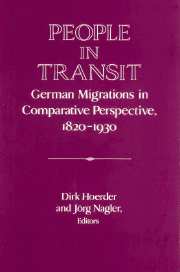Book contents
- Frontmatter
- Introduction
- PART I CONTINUITY AND COMPLEXITY: MIGRATIONS FROM EAST ELBIAN GERMANY AND GALICIAN POLAND
- Part II Internal German Migrations and In-Migrations
- 6 Traveling Workers and the German Labor Movement
- 7 Migration in Duisburg, 1821-1914
- 8 In-Migration and Out-Migration in an Area of Heavy Industry: The Case of Georgsmarienhütte, 1856-1870
- 9 Foreign Workers in and around Bremen, 1884-1918
- PART III WOMEN'S MIGRATION: LABOR AND MARRIAGE MARKETS
- PART IV ACCULTURATION IN AND RETURN FROM THE UNITED STATES
- 18 Migration Past and Present - The German Experience
- 19 Research on the German Migrations, 1820s to 1930s: A Report on the State of German Scholarship
- Index
7 - Migration in Duisburg, 1821-1914
Published online by Cambridge University Press: 05 January 2013
- Frontmatter
- Introduction
- PART I CONTINUITY AND COMPLEXITY: MIGRATIONS FROM EAST ELBIAN GERMANY AND GALICIAN POLAND
- Part II Internal German Migrations and In-Migrations
- 6 Traveling Workers and the German Labor Movement
- 7 Migration in Duisburg, 1821-1914
- 8 In-Migration and Out-Migration in an Area of Heavy Industry: The Case of Georgsmarienhütte, 1856-1870
- 9 Foreign Workers in and around Bremen, 1884-1918
- PART III WOMEN'S MIGRATION: LABOR AND MARRIAGE MARKETS
- PART IV ACCULTURATION IN AND RETURN FROM THE UNITED STATES
- 18 Migration Past and Present - The German Experience
- 19 Research on the German Migrations, 1820s to 1930s: A Report on the State of German Scholarship
- Index
Summary
When Napoleon passed through Duisburg in November 1811, he found a town still much like the provincial market center that had existed on a flat plain near the confluence of the Rhine and Ruhr rivers 350 years before. Even though its population had reached about five thousand, its subordinate economic stature was clearly manifest as the town had fallen into the commercial orbit of the Netherlands. Reflecting its basic economic fortune as a modest market town, Duisburg's three main roads as well as city streets and alleyways were in very poor repair. The city walls were hardly visible through overgrown vegetation. Much to the relief of occupying administrators, Duisburg was a peaceful community and the population hung onto an old-fashioned morality of hard work and possessed a conservative mentality. Although the Prussians returned in 1815, Duisburg did not change measurably. With the exception of textiles, tobacco processing, soap manufacturing, and those firms engaged in the transshipment of goods, the city's economy continued its provincial orientation toward the local market. Demand for Duisburg's products was by no means assured, however. The 1820s and 1830s were particularly difficult years for agriculture in the lower Rhine, causing economic uncertainty in both town and countryside. Over the next several decades, however, local businessmen invested in improving harbor facilities and in several processing plants, hoping to take advantage of the geographical position of their city. In the 1830s and 1840s, Duisburg experienced two business cycles, with peak years in 1830-34 and 1842-46.
- Type
- Chapter
- Information
- People in TransitGerman Migrations in Comparative Perspective, 1820–1930, pp. 147 - 176Publisher: Cambridge University PressPrint publication year: 1995
- 1
- Cited by



